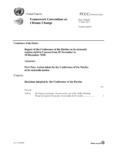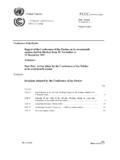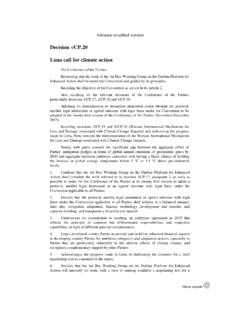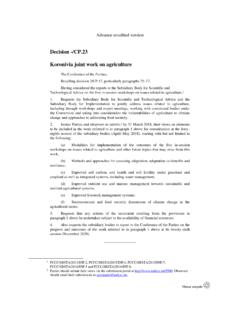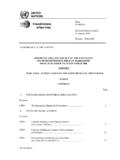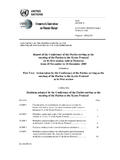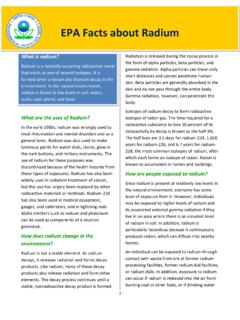Transcription of Climate Action Plan 2050 - UNFCCC
1 Climate Action plan 2050. Principles and goals of the German government's Climate policy Preamble .. 2. 1. Introduction .. 5. 2. Climate Action as a strategy to modernise our economy .. 10. 3. International context (global and EU) .. 13. Multilateral framework .. 13. EU Climate targets for 2050 and 16. The Climate Action plan 2050 in the context of European Climate policies .. 17. 4. The path toward greenhouse gas neutrality in Germany .. 19. Transformation of the economy and society by 19. Target setting and description of the pathway up to 21. Promoting Climate Action at all levels Climate Action as a societal project 23. 5. Targets and measures .. 27. Climate Action in the energy sector .. 29. Climate Action in the buildings 38.
2 Climate Action and mobility .. 47. Climate Action in industry and business .. 56. Climate Action in agriculture .. 62. Climate Action in land use and forestry .. 67. Overarching goals and measures .. 73. 6. Implementing and updating the Climate Action plan .. 82. Abbreviations .. 84. German ministries, organisations, legislation and government 86. Preamble The coalition agreement for the 18th legislative period includes a stipulation to produce a Climate Action plan 2050, which would make Germany's existing Climate targets for 2050 and the interim targets agreed more specific and align them with the outcomes of the 2015 Climate Change Conference in Paris. The plan would also detail measures to achieve those targets.
3 The Climate Action plan 2050 outlines the basic principles for implementing Germany's long-term Climate Action strategy, thus providing essential guidance for all actors in the economy, society and the scientific and academic community. Designed to be a process capable of incorporating new insights and developments, its basic philosophy centres on regular reviews, continuous learning and constant improvement. In this sense, it cannot and does not seek to be a detailed master plan for decades to come. The Paris Conference set the global Climate change efforts on a completely new and ambitious footing: all 196 Parties to the UN Framework Convention on Climate Change agreed on a common goal and approach to combatting Climate change.
4 We intend to keep global warming well below 2 degrees Celsius above pre-industrial levels and are aiming to limit the temperature increase to degrees Celsius. Back in 2010 well before the Paris Conference the German government decided to reduce greenhouse gas (GHG) emissions by 80 to 95 per cent compared with 1990 levels by 2050. It has reaffirmed this long-term target and in pursuing it will make an appropriate contribution to implementing the commitment made in Paris, also with a view to the goal set out in the Paris Agreement of achieving global greenhouse gas neutrality in the second half of the century. At the G7 summit in Elmau in June 2015 we, in conjunction with the other leading industrialised nations, pledged to make our contribution to decarbonising the global economy over the course of this century.
5 One of the ways of achieving that would be by developing and using innovative technologies. In May 2016, the G7 countries also underpinned their leading role by committing to early, transparent and robust implementation of their Nationally Determined Contributions (NDCs) under the Paris Agreement and by promoting increased ambition over time. Germany has already achieved a great deal within this process, by supporting renewable energy technologies for example. This has made it possible for quantum technological leaps to be taken that have also made a positive contribution to international Climate Action . Germany will continue in the future to meet its special responsibility as an industrialised country in the field of Climate Action .
6 Because of our particular responsibility as the strongest economy in the EU, one of the goals we are already aiming for with this Climate Action plan is to be largely greenhouse gas neutral by mid-century. It is important to bear in mind here that the sum of the NDCs (national Climate change pledges) that are the backbone of the Paris Agreement is not enough 2. to keep global warming below 2 degrees. It is therefore crucial that all parties surpass their current pledges. Germany has achieved a great deal in terms of Climate Action and in progressing its Energiewende1 without compromising industry's competitiveness. Notwithstanding the structural adjustments and learning costs associated with these processes of change, it has also created new economic opportunities and innovations.
7 The German government intends to continue on its chosen path, which will include consistently implementing the objectives that are part of the Energiewende. While doing this, it will focus attention on making sure German industry remains competitive and has well-functioning, innovative and closed-loop value chains. The Climate Action plan 2050 does not contain any rigid targets; the goals it sets are characterised by a technology-neutral and innovation-friendly approach. It provides guidance for upcoming investments, especially for the period up to 2030. The Bundestag will put specific legislative measures in place. A successful Climate policy must be systematically geared to creating future opportunities, define a clear framework, promote research and innovation, and help businesses to invest in future- proof sustainable technologies and therefore avoid stranded investments.
8 We are seeking to instigate the changes needed without structural breaks. We need to make use of the strength and creativity of Germany's market economy, combined with the forces of competition, to ensure we achieve the existing national, European and international Climate targets. German industry's strength in innovation and research has huge potential to develop new technologies. The existing Climate targets need open competition to elicit the best ideas and technologies and we intend to support that. The Climate Action plan 2050 is both the basis and a guideline for identifying and fleshing out Climate Action strategies and measures in the different areas of Action . How exactly they are to be fleshed out should be explored with the active participation of the business sector and civil society actors.
9 There is no doubt that the government will assess and politically evaluate the economic, social and environmental impact of any specific measures. This will ensure that the German business sector maintains its ability to compete internationally. It will also create planning certainty for enterprises, private households and consumers and ensure that it is possible to respond flexibly to technological innovations, for example. In the Climate Action plan 2050, the German government has agreed on sectoral targets which describe the pathway up to 2030 for the proportional reduction of greenhouse gases. Since the sectoral targets may in some cases have a far- reaching impact on our economic and social development, they will undergo a comprehensive impact assessment, the findings of which will be discussed with all social partners and which will enable us to modify the sectoral targets in 2018.
10 1. The decision of the German government to both decarbonise the energy supply and abstain from using nuclear power 3. The Climate Action plan 2050 will be modified at regular intervals to ensure it takes societal, political, social, economic and environmental developments and changes into account. It will therefore be regularly updated, in keeping with the Paris Agreement and reflecting the learning process. The aim is to regularly check the effectiveness of the measures and modify them wherever necessary. This will be carried out transparently and through a process of dialogue with all stakeholders. 4. 1. Introduction Tackling Climate change calls for a long-term approach. The German government's Climate policy is guided by the Paris Agreement, which was adopted in December by the Parties to the United Nations Framework Convention on Climate Change.
